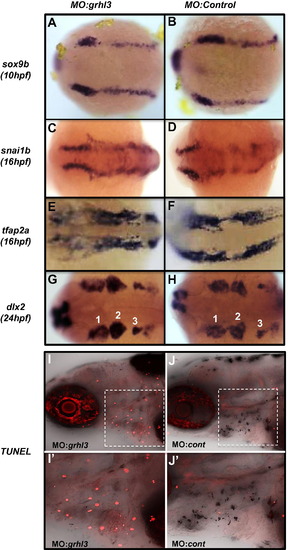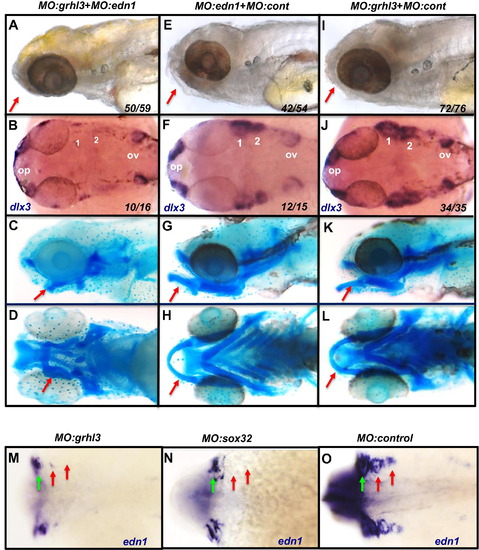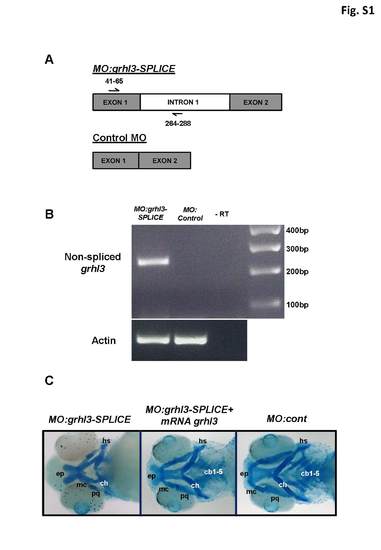- Title
-
Grainyhead-like 3 regulation of endothelin-1 in the pharyngeal endoderm is critical for growth and development of the craniofacial skeleton
- Authors
- Dworkin, S., Simkin, J., Darido, C., Partridge, D.D., Georgy, S.R., Caddy, J., Wilanowski, T., Lieschke, G.J., Doggett, K., Heath, J.K., Jane, S.M.
- Source
- Full text @ Mech. Dev.
|
Loss of grhl3 causes defects in lower-jaw growth and development. (A-F) grhl3 is expressed in the medial endoderm (me) and developing endodermal pouches (ep) of the pharynx. Expression persists throughout the pharyngeal arches (white arrows) until at least 96 hpf (A-C, lateral view, anterior to left, inset in A shows cross-section in the plane of dotted line; D, dorsal view; E and F, ventral views). (G and H) Following MO-mediated knockdown of grhl3, fish exhibit defective craniofacial development when visualised by brightfield microscopy. (I and J) Scanning Electron Microscopy (SEM) at 48 hpf shows defective formation of the ventral region of the mouth (red arrows) in grhl3-morphants (I) relative to controls (J). (K–N) Lateral (K, L) and ventral (M, N) views of Alcian Blue stained cartilage displaying severe hypoplasia (palatoquadrate [pq], ceratohyal [ch] Meckel’s cartilage [mc]) or absence (basihyal [bh], ceratobranchials [cb]) of jaw structures in grhl3 morphants relative to controls. The hyosymplectic (hs) and ethmoid plate (ep) display minimal changes in grhl3 morphants at 96 hpf. |
|
Neural crest cell specification, migration and pharyngeal homing are unaffected in grhl3-morphants. (A-H) The expression of neural crest specification (sox9b, 10 hpf), migration (snai1b and tfap2a, 16 hpf) and pharyngeal homing (dlx2, 24 hpf) marker genes is not differentially regulated in grhl3 morphants relative to controls. (I and J′) apoptosis analysis (TUNEL, 72 hpf) shows that loss of grhl3 leads to increased cell death in the arches (I-I′) relative to controls (J-J′). PHENOTYPE:
|
|
Endothelin-1 is a direct target of grhl3. (A) Micro-ChIP assay from 24 hpf zebrafish expressing grhl3 (as a negative control for FLAG-Ab binding) or grhl3-FLAG shows an enrichment in binding at three out of four predicted binding sites in the edn1 promoter in the grhl3-FLAG-injected group. Sites are shown relative to the transcription start site (TSS). No enrichment in binding is seen at predicted site 2, or within the negative-control (Exon 2, coding) region. (B-G) The expression of edn1 (B, C) is lost in grhl3 morphants at 24 hpf, as is expression of dlx3 (D, E) and hand2 (F, G), although note persistent expression of dlx3 in the olfactory placode (op) and otic vesicles (ov), and hand2 within the heart (h). (1-2; pharyngeal arches 1-2). EXPRESSION / LABELING:
|
|
grhl3 and endoderm-derived edn1 are epistatic in lower jaw development (A-L) sub-phenotypic injection of MO: edn1 together with MO: grhl3 leads to defective jaw development (A), loss of dlx3 expression in the pharyngeal arches (B) and hypoplastic facial cartilage at 96 hpf (C, lateral view; D, ventral view). These defects are not observed in sub-phenotypic co-injection of either MO: edn1 (E and H) or MO: grhl3 (I-L) with MO: control. (M-O) The expression of edn1 at 22 hpf in grhl3-morphants (M) is similar to that in endoderm-deficient sox32-morphants (N); both morphants continue to express edn1 in the ectoderm of the first arch (green arrows) but exhibit greatly reduced or absent edn1 expression in the endodermal pouches of both the first and subsequent arches (red arrows) relative to controls (O). EXPRESSION / LABELING:
PHENOTYPE:
|
|
Pharyngeal and jaw defects in grhl3-morphants are rescued by edn1 mRNA. (A-F) edn1, dlx3 and hand2 are lost in grhl3-morphants but are restored (arrows) following rescue by edn1 mRNA at 24 hpf. (G-J) Lower jaw cartilage defects in grhl3-morphants are rescued by re-expression of edn1. (G and H, lateral views; I-J, ventral views; 96 hpf; ep, ethmoid plate; hs, hyosymplectic; mc, Meckel’s cartilage; pq, palatoquadrate; bh, basihyal; ch, ceratohyal; cb1-3, ceratobranchials 1-3. (K) Quantitation of rescue of lower jaw phenotypes following edn1 mRNA injection into grhl3-morphants. The proportion of phenotypically-WT fish is significantly increased in edn1-rescued grhl3-morphants; (+) compared to non-rescued morphants (-); similarly, the proportion of fish displaying either mild or severe defects is significantly reduced in edn1-rescued morphants. EXPRESSION / LABELING:
|
|
Endodermal edn1 is required for NCC maintenance in the pharyngeal arches. (A-D) EdU incorporation analysis (48 hpf) shows that grhl3-morphants exhibit decreased proliferation in the lower-jaw primordium of the pharyngeal arches (dotted regions) relative to controls (A and B′); this proliferation is restored to WT levels in edn1-rescued grhl3-morphants (C-C′). These data were quantitated using unpaired t-test with Welch’s correction (D). (E) Our model suggests that endodermal edn1, regulated by grhl3, is required in order to provide pro-proliferative/survival signals for NCCs within the pharyngeal arches. This interaction may be direct, via homeostatic maintenance of total pharyngeal edn1-signalling, or through both mechanisms, in order to provide to allow subsequent NCC differentiation into the complete craniofacial skeleton. PHENOTYPE:
|
|
A grhl3 Exon1/Intron1 splice-blocking morpholino confirms specific targeting of grhl3. (A) Schematic of PCR-primers used to detect non-spliced reverse-transcribed mRNA product following block of grhl3-splicing. (B) The non-spliced grhl3 product was detectable by RT-PCR; this product was absent in MO:control injected fish. (C) The craniofacial phenotype seen following grhl3- knockdown was largely rescued by re-injection of morphants (at the 2-4 cell stage) with grhl3 mRNA, confirming target-specificity; ep, ethmoid plate; hs, hyosymplectic; mc, Meckel’s cartilage; pq, palatoquadrate; ch, ceratohyal; cb1-5, ceratobranchials 1-5. |
|
A grhl3 exon1-intron1 splice-blocking reproduces the edn1-pathway down-regulation seen following use of the ATG-blocking MO. (A-B) Brightfield microscopy showing defective lower jaw development in grhl3-splice-morphants (A) compared to controls (B) (C-F) Alcian blue staining highlighting defective cartilage patterning, showing lateral (C-D) and ventral (E-F) views of grhl3- splice-morphants. (G-N) Expression of pharyngeal markers at 24hpf following injection of the grhl3 splice-blocking MO, showing dlx2in the dorsal arches is unchanged (G, H), whereas the expression of edn1 (I, J), dlx3 (K, L) and hand2 (M, N) is greatly reduced in grhl3-splice-morphants. |
|
Pharyngeal arch regions used for IMARIS cell-proliferation quantitation. Representative confocal images of EdU-labelled controls (A), grhl3-morphants (B) and edn1-rescued grhl3-morphants (C), together with automated cell counts per image. Embryos were imaged with the Olympus Inverted FV1000, and pharyngeal arch (PA) cell counts were completed using IMARIS V7.6. Here, BA1 and 2 were selected (in the x, y and z axis) using the surface tool to both calculate arch volume, and create a new channel using the mask selection tool. Cell counts were completed on this new channel using the spots tool with estimated diameter set to 5µm, background subtraction on, sphere detection on, and IMARIS quality threshold minimum set to 45-70 (quality threshold maximum was set to maximum). |
Reprinted from Mechanisms of Development, 133, Dworkin, S., Simkin, J., Darido, C., Partridge, D.D., Georgy, S.R., Caddy, J., Wilanowski, T., Lieschke, G.J., Doggett, K., Heath, J.K., Jane, S.M., Grainyhead-like 3 regulation of endothelin-1 in the pharyngeal endoderm is critical for growth and development of the craniofacial skeleton, 77-90, Copyright (2014) with permission from Elsevier. Full text @ Mech. Dev.









